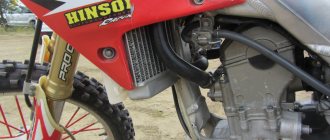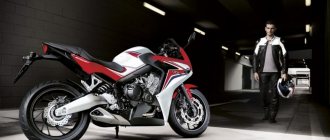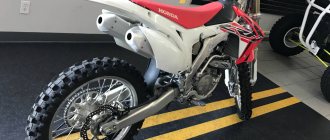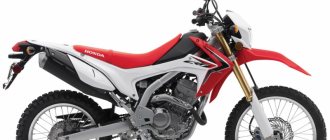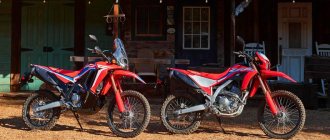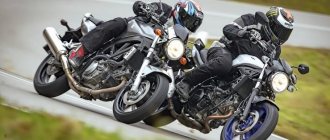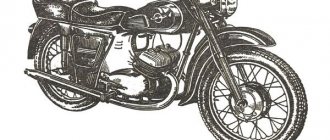Honda CRF 250 motocross motorcycle
Honda CRF 250 is a cross-country motorcycle that first saw the light back in 2000. Its predecessor was the off-road series with the XR index. Initially, the car was planned as a flagship in the model range, so it immediately received all the technical innovations available at that time: electronically controlled fuel injection, a damper with progressive damping on the steering column, titanium alloy valves and much more. The power unit is single-cylinder, with a cylinder volume of 250 cm³ and a power from 30 to 43.7 liters. With. depending on modification. The torque of the power unit is 25 Nm. Nowadays, despite its advanced age, the Honda CRF 250 continues to occupy a leading position in the market niche of motocross and enduro motorcycles.
Modifications and production history
Honda CRF250 is available in 4 specifications:
- CRF 250 X – enduro version;
- CRF 250 R – cross-country version;
- CRF 250L and CRF 250M are budget models for untrained pilots.
As already mentioned, the history of the production of devices began in 2000. Over such a long period, they would inevitably become outdated if not for periodic modernizations. Initially, all versions were produced with a carburetor power system. Since 2010, the Honda CRF 250R modification has received a PGM-Fi injection system with control electronics. Since 2011, the Honda CRF 250 begins to be equipped with a reinforced aluminum frame and updated suspensions. The CRF 250 X modification receives LED optics based on LED elements.
Honda CRF 250
Model history
2012 - start of production and sales of Honda CRF250L in the Asian market. Model: Honda CRF250L (Asia).
2013 - appearance of motard modification Honda CRF250M. Both models are officially available in Europe and North America. Model: Honda CRF250L; Honda CRF250M (all markets). Factory designation: CRF250LD; CRF250ME.
2014 - no significant changes. Model: Honda CRF250L; Honda CRF250M (all markets). Factory designation: CRF250LE; CRF250ME.
2015 - no significant changes. Model: Honda CRF250L; Honda CRF250M (all markets). Factory designation: CRF250LF; CRF250MF.
2016 - no significant changes. Model: Honda CRF250L (all markets). Factory designation: CRF250LG.
2017 - the Honda CRF250M model leaves the European and American markets, a new modification appears - the Honda CRF250L Rally. The engine undergoes minor changes, increasing power slightly. The appearance of versions with ABS. Model: Honda CRF250L (ABS); Honda CRF250L Rally (ABS) (all markets). Factory designation: CRF250LH + CRF250LAH (ABS); CRF250RLH + CRF250RLAH (ABS).
2018 - no significant changes. Model: Honda CRF250L (ABS); Honda CRF250L Rally (ABS) (all markets). Factory designation: CRF250LJ + CRF250LAJ (ABS); CRF250RLJ + CRF250RLAJ (ABS).
2019 - no significant changes. Model: Honda CRF250L (ABS); Honda CRF250L Rally (ABS) (all markets). Factory designation: CRF250LK + CRF250LAK (ABS); CRF250RLK + CRF250RLAK (ABS).
2020 is the last year of production for foreign markets. Model: Honda CRF250L (ABS); Honda CRF250L Rally (ABS) (all markets). Factory designation: CRF250LL + CRF250LAL (ABS); CRF250RLL + CRF250RLAL (ABS).
2021 - the model is restyled, receiving the base from the new CRF300L. Starting this year, the model is available only for the Asian market. Model: Honda CRF250L (ABS); Honda CRF250L Rally (ABS) (Asia).
Technical description
Both modifications 250 X and 250 R are equipped with the same 1-cylinder 249 cc water-cooled engines. Start - electric starter. They differ in compression ratio, power, ignition and power systems.
The Honda CRF 250 X motorcycle has a combustion chamber with a compression ratio of 13.5. Develops a maximum power of 43.7 hp. With. at 11 thousand rpm. The highest torque of 25 Nm is achieved at 8 thousand rpm. The injection system is injection, with control electronics. Ignition is transistorized.
The Honda CRF250R has a lower compression ratio of 12.9 and a correspondingly lower power output of 30 hp. With. at 9 thousand rpm. The fuel delivery system uses a Keihin carburetor with throttle position sensor and 37mm jets. Electronically controlled ignition CDi.
Gearboxes are only mechanical, with 5 steps. Torque is transmitted to the rear wheel by a chain. Aluminum frame, extruded (injection molding technology).
Video review of Honda CRF 250
The front fork is an inverted type, twin-tube, telescopic, Showa brand with a full range of adjustments. The Honda CRF 250 X has fork legs with a diameter of 49 mm and suspension travel of 310 mm. The Honda CRF 250 R has a 47 mm fork and 315 mm of travel. Steering column with Honda progressive steering damper.
The rear suspension is pendulum, with a progressive Pro-Link Showa monoshock absorber, which has a full range of adjustments. The only difference is the suspension travel: for the CRF 250 X it is 312 mm, and for the CRF 250 R it is 315 mm.
Front wheel with tire size 80/100 R21. The rear ones are different: the CRF 250 X has 100/90 R19, and the CRF 250 R has 100/100 R18. Aluminum rims with wire spokes. The front brake is single disc, with 2-piston caliper. The only differences are in the size of the disc: for the CRF 250 X it has a diameter of 260 mm, for the CRF 250 R it has a diameter of 240 mm. The rear brake is the same: one disc with a diameter of 240 mm and a 1-piston caliper. Both brakes are hydraulic, the brake pads are metallized.
The fuel tank capacity of the CRF 250 X is 6.5 liters, and that of the CRF 250 R is 7.2 liters. There are also slight differences in the curb weight: for the 250 X modification it is 105 kg, for the 250 R it is 115 kg.
Honda CRF 250
Characteristics:
Specifications of Honda CRF250L (CRF250M, CRF250L Rally):
| Model | Honda CRF250L |
| Motorcycle type | CRF250L – enduro, CRF250M – motard, CRF250L Rally – dual sport |
| Year of issue | 2012+ |
| Frame | steel half-duplex |
| engine's type | 1-cylinder, 4-stroke |
| Working volume | 249.6 cm³ |
| Bore/Stroke | 76.0 x 55.0 mm |
| Compression ratio | 10.7:1 |
| Cooling | liquid |
| Number of valves per cylinder | DOHC, 4 valves |
| Fuel supply system | Injector, PGM-Fi x1 36mm – CRF250L/M (2012-2016) Injector, PGM-Fi x1 38mm – CRF250L/M (2017+), CRF250L Rally |
| Ignition type | fully transistorized |
| Maximum power | 22.8 hp (17.0 kW) at 8500 rpm – CRF250L/M (2012-2016) 25.0 hp (18.2 kW) at 8500 rpm – CRF250L/M (2017+), CRF250L Rally 24.0 hp (18.0 kW) at 9000 rpm – CRF250L (2021+), CRF250L Rally (2021+) |
| Maximum torque | 22.0 Nm (2.3 kg*m) at 6500 rpm – CBR250R (2011-2013) – CRF250L / M (2012-2016) 22.6 Nm (2.4 kg*m) at 6750 rpm – CBR250R (2015-2017) – CRF250L / M (2017+), CRF250L Rally 23.0 Nm (2.5 kg*m) at 6500 rpm – CRF250L (2021+), CRF250L Rally (2021+) |
| Clutch | Multi-disc in oil bath, cable drive Assist & Slipper clutch - 2021+ |
| Transmission | 6-speed |
| type of drive | chain |
| Front tire size | 3.00-21 51P – CRF250L, CRF250L Rally 110/70-17M/C 54S – CRF250M 80/100-21M/C 51P – CRF250L (2021+), CRF250L Rally (2021+) |
| Rear tire size | 120/80-18M/C 62P – CRF250L, CRF250L Rally 130/70-17M/C 62S – CRF250M |
| Front brakes | 1 disc, 256 mm, 2-piston caliper (ABS – 2017+) – CRF250L 1 disc, 296 mm, 2-piston caliper (ABS – 2017+) – CRF250L Rally, CRF250M |
| Rear brakes | 1 disc, 220 mm, 1-piston caliper (ABS – 2017+) |
| Front suspension | 43 mm inverted telescopic fork (non-adjustable), 250 mm travel 43 mm inverted telescopic fork (non-adjustable), 260 mm travel – CRF250L (2021+), CRF250L Rally (2021+) |
| Rear suspension | Pro-link pendulum with monoshock absorber (preload adjustment), stroke - 240 mm - CRF250L / M Pro-link pendulum with monoshock absorber (preload adjustment), travel - 265 mm - CRF250L Rally Pro-link pendulum with monoshock absorber (preload adjustment), travel - 260 mm - CRF250L (2021+), CRF250L Rally (2021+) |
| Motorcycle length | 2195 mm – CRF250L 2210 mm – CRF250L Rally, CRF250L (2021+) 2200 mm – CRF250L Rally (2021+) 2127 mm – CRF250M 2230 mm – CRF250L Rally S (2021+), CRF250L S (2021+) |
| Motorcycle width | 815 mm – CRF250L, CRF250M 900 mm – CRF250L Rally 820 mm – CRF250L (2021+) 920 mm – CRF250L Rally (2021+) |
| Motorcycle height | 1195 mm – CRF250L 1425 mm – CRF250L Rally 1147 mm – CRF250M 1160 mm – CRF250L (2021+) 1200 mm – CRF250L S (2021+) 1355 mm – CRF250L Rally (2021+) 1415 mm – CRF250L Rally S (2021+) |
| Wheelbase | 1445 mm 1440 mm – CRF250L (2021+) 1435 mm – CRF250L Rally (2021+) 1455 mm – CRF250L S (2021+), CRF250L Rally S (2021+) |
| Seat height | 875 mm – CRF250L 895 mm – CRF250L Rally 855 mm – CRF250M 830 mm – CRF250L (2021+), CRF250L Rally (2021+) 880 mm – CRF250L S (2021+) 885 mm – CRF250L Rally S (2021+) |
| Minimum ground clearance (clearance) | 255 mm – CRF250L 270 mm – CRF250L Rally 225 mm – CRF250M 245 mm – CRF250L (2021+) 285 mm – CRF250L S (2021+) 220 mm – CRF250L Rally (2021+) 275 mm – CRF250L Rally S (2021+) |
| Acceleration 0-100 km/h (0-60 mph) | |
| Maximum speed | |
| Gas tank capacity | 7.8 l – CRF250L, CRF250M 10.1 L – CRF250L Rally 12.8 L – CRF250L Rally (2021+) |
| Motorcycle weight (curb) | 143 kg – CRF250L 146 kg – CRF250L (ABS) 157 kg – CRF250L Rally 145 kg – CRF250M 140 kg – CRF250L (2021+) 152 kg – CRF250L Rally (2021+) |
dimensions
Models TsRF 250 X and TsRF 250 R have the following overall dimensions:
- length – 2174 mm;
- width – 827 mm;
- handlebar height – 1261 mm;
- wheelbase – 1481 mm;
- saddle height – 958 mm;
- ground clearance - 346 mm;
- The departure angle of the front fork is 27.50.
Honda CRF 250
Motorcycle performance ratings
Both models, according to owners' reviews, provide good technical characteristics in comparison with competitors, have high off-road qualities and are comfortable enough for long driving.
Honda engines are famous for their high power density, low noise (89.9 dB - high for motocross bikes), reliability and durability. Starting the engine using an electric starter is very convenient.
There are also disadvantages. Despite the fact that the electronic injection engine accelerates excellently on short stretches, it behaves mediocrely on long stretches. The power is excellent at medium speeds, not bad at low speeds, but at the top the engine smokes and roars more. The problem is that the standard muffler suffocates the engine too much. The use of a tuning exhaust improves power at the top, but there is no trace of low noise.
Carburetor versions suffer from failures when opening the gas, which does not provide the necessary pickup when exiting turns and landing after jumps. But with a highly skilled approach with the right needle and set of jets, it is still possible to achieve a clear response to the gas.
Thanks to the use of electronic injection on the CRF 250 X, the ignition circuits can be changed simply by reprogramming the control module. This is a modern analogy to replacing jets in carburetors.
The frames have also proven to be highly wear-resistant and sufficiently rigid. The use of aluminum alloy in their design made it possible to reduce the overall weight of the motorcycle. Due to the use of a front fork with insufficient lean angle, the motorcycle suffers from oversteer when entering corners. This manifests itself in the fact that the steering wheel tends to escape from your hands when entering a turn, and on straight sections there is a need to constantly adjust the trajectory. The deficiency is cured by installing a rear pendulum of an extended design.
For all heavier riders (over 75kg), it is recommended to change the fork springs to stiffer ones to prevent the front wheel from diving under braking.
Honda CRF 250
Post Views: 22,481
MY MOTORCYCLE
Many lovers of speed and connoisseurs of freedom prefer a motorcycle, because a bike is a universal means of transportation that allows you to get anywhere. It was for people like them that a special series of Dual Sport or dual-purpose motorcycles was created. In fact, these are two-wheeled analogues of SUVs that can crawl through such jungles that the owners of some bikes are afraid to even imagine.
The main competitors in this class of motorcycles are Honda, Kawasaki and Yamaha; each company offers customers its own version of the Dual Sport bike in the category of four-stroke “quarters”, which differ little from each other in their features and price. However, manufacturers do not stand still and are trying to make their models more and more advanced. Honda was one of the last to update its dual-purpose bike, which can easily conquer asphalt and off-road.
The Honda CRF250L easily overcomes dirt roads or domestic off-road conditions. Many people use this “multi-purpose” motorcycle for long journeys.
Just take one look at the Honda CRF250L and you'll immediately notice how impressive it looks. The motorcycle has a streamlined shape and clear lines. Particularly striking is the engine and the method by which the engineers hid all the wires and pipes. This Honda looks much more expensive than it actually costs. At the same time, they did not skimp on the motorcycle - it is made of very high quality materials. The CRF has a low seat height of 88 cm, which is 2.5 cm less than the Kawasaki and 5 cm less than the Yamaha WR. This will be good news for those who are short in stature. However, those who are taller than 180 centimeters will find it difficult to stand up on the footrests when riding off-road - the handlebars of the motorcycle are located at the ideal level for riding while sitting, by the way, and the seat on it is quite comfortable.
When measuring the parameters, it turned out that the Honda has the heaviest weight compared to its competitors - 145 kg, although this is not felt while driving. This is thanks to the responsive and reliable engine, which starts instantly in any conditions by pressing the starter button. The engine has direct fuel injection and there are no problems with its operation, even when the street is below zero. The powerful power unit, together with a very sensitive clutch, makes it clear that the vehicle is not created for entertainment. The gauges are easy to read, especially the fuel gauge, something neither Kawasaki nor Yamaha can boast of.
When driving on the road, the CRF behaves perfectly. The motorcycle accelerates to hundreds faster than its competitors - in just 8.6 seconds, however, with such dynamics, the engine is quite responsive when compared with similar models with an engine capacity of 250 cm3. Riders who like to listen closely to the exhaust note will appreciate its subdued tonality. At idle, the volume of the muffler is 72 dB, while driving - from 86 dB.
The power unit of the Honda CRF250L is borrowed from the sports CBR250R, although for off-road driving the designers had to slightly deboost it and “tighten up” the torque.
When measuring the revolutions, it turned out that the torque of the Honda CRF250L is higher than that of the Kawasaki motorcycle - 18.43 Nm, but this is less when compared with the WR. The maximum engine power can be squeezed out already at the bottom. This is why Honda has much more flexibility than others. If we compare horsepower, then its number is the same as that of the KLX, but 25% less than that of the Yamaha.
It is not surprising that having the heaviest weight and not the most impressive reserve of heads in the herd of horsepower, the Honda CRF250L runs a distance of 400 meters slower than its competitors - in 19.64 seconds, while accelerating to 121 km/h. But this had a beneficial effect on fuel consumption. The owner of a Honda CRF250L will need only 1 liter per 27 km, that is, once you fully fill the tank, you can travel a distance of 200 km. Some people will like this efficiency, but for many people who like to drive off-road, this is not a plus.
Excellent stopping power is provided by wavy disc brakes. The model is equipped with all the necessary lighting equipment to drive on roads intended for public use.
Many bikers will appreciate the smooth power delivered throughout the engine's entire operating range. On the road the bike behaves very well, but it also has some disadvantages, for example, the lack of “jerk”, so for those who like to ride with the front wheel jumping over obstacles, this will be a big problem. An excessively long second gear is also not conducive to active driving. You will often have to make a choice - leave the motorcycle running in second and put up with the roar of the engine, or strain to climb the hills and taxi through the mud in third.
Another detail that may influence the decision not to ride the Honda CRF250L in the mud is that the motorcycle’s suspension is not performing well. The front wheels carry less than 30 percent of the weight when the biker is in the saddle, so at certain moments, in order to steer, you have to lean towards the handlebars and thus try to maintain balance and at the same time give the front wheel momentum for better traction. This problem cannot be solved even by adjusting the shock absorbers, which, by the way, are quite difficult to adjust, since for some reason the necessary keys are not included in the standard set of tools for a motorcycle.
The front brake mechanism also does not work well. It is not very informative when you squeeze the lever, so the driver may have difficulty controlling the motorcycle on rocks and various uneven surfaces. However, with all this, it demonstrated amazing efficiency when braking on asphalt surfaces from a speed of 100 km/h to 0. The braking distance was only 37 meters, this figure is one meter less than the WR and slightly more when compared with the Kawasaki. The rear brake works perfectly for a motorcycle of this class.
Apparently, the Honda CRF250L is primarily intended for beginners. Although the engine is very smooth, it does not have the wildness that people buy motorcycles for. However, normal driving around the city and the safety of the motorcyclist on this vehicle are quite possible. Therefore, Honda’s attempt to gain new fans can be considered successful.
Honda CRF250L, technical specifications:
| Motor and drive | |
| engine's type | Single cylinder |
| Number of cycles | 2 |
| Volume | 250.00 cm³ |
| Diameter*Stroke | 76.0 mm x 55.0 mm |
| Valves per cylinder | 4 |
| Compression ratio | 10.7:1 |
| Power | 25.30 l. With. @ 9500 rpm |
| Torque | 18.70 Nm @ 7000 rpm |
| Fuel system | Fuel injection |
| Cooling system | Liquid cooling |
| Ignition | Electronic ignition |
| Fuel control | DOHC |
| Clutch | Multi-disc, oil bath |
| Transmission | 6-speed |
| Drive unit | Chain |
| Fuel consumption | 5.50 l/100km |
| Maximum speed | 140.0 km/h |
| Chassis | |
| Frame | Tubular. Steel |
| Front suspension | 43 mm Inverted type. Customizable |
| Front suspension travel | 250 mm |
| Rear suspension | Pendulum. Monoshock absorber. Pro-Link |
| Rear suspension travel | 240 mm |
| Fork angle | 27.6° |
| Discs | Spoke |
| Front wheel size | 3.00–21 |
| Rear wheel size | 120/80-18 |
| Front brake | Disk, 1 disk |
| Front brake diameter | 256 mm |
| Rear brake | Disk, 1 disk |
| Rear brake diameter | 220 mm |
| Weight and dimensions characteristics | |
| Length | 2195 mm |
| Width | 815 mm |
| Height | 1195 mm |
| Seat height | 875 mm |
| Minimum ground clearance | 255 mm |
| Wheelbase | 1445 mm |
| Curb weight | 144.0 kg |
| Power/weight ratio | 0.1757 |
| Gas tank capacity | 7.7 l |
